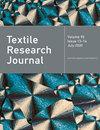Rapid quantitative analysis of natural indigo dye content using near-infrared spectroscopy
IF 1.9
4区 工程技术
Q2 MATERIALS SCIENCE, TEXTILES
引用次数: 0
Abstract
Natural indigo, the most widely produced and utilized natural dye, encounters quality challenges due to the lack of standardization in the natural dye industry. Rapid determination of natural indigo dye contents before the dyeing process appears extremely important. In this study, two prediction models for different concentrations were established using partial least squares in conjunction with near-infrared analysis quantitatively to analyze the natural indigo dye content. A total of 228 indigo samples were collected from 14 different dyestuffs across various regions, with concentrations ranging from 100 to 1000 mg/L and 10 to 100 mg/L, respectively. The spectral pre-processing methods of multiplicative scatter correction plus first-order derivative and Savitzky–Golay smoothing plus band normalization plus first-order derivative were selected to enhance the model prediction accuracy. The optimized model exhibited excellent prediction accuracy. Within the concentration range of 100–1000 mg/L, the model has an R利用近红外光谱快速定量分析天然靛蓝染料含量
天然靛蓝是生产和使用最广泛的天然染料,但由于天然染料行业缺乏标准化,其质量面临挑战。在染色过程之前快速测定天然靛蓝的染料含量显得极为重要。本研究利用偏最小二乘法结合近红外分析法建立了两个不同浓度的预测模型,定量分析天然靛蓝染料含量。研究人员从不同地区的 14 种不同染料中采集了共计 228 个靛蓝样本,浓度范围分别为 100 至 1000 mg/L 和 10 至 100 mg/L。为提高模型的预测精度,选用了乘法散射校正加一阶导数和萨维茨基-戈莱平滑加带归一化加一阶导数的光谱预处理方法。优化后的模型具有极高的预测精度。在 100-1000 mg/L 浓度范围内,模型的 R2 值为 0.9994,预测值的均方根误差为 6.36 mg/L。在 10-100 毫克/升的浓度范围内,模型的 R2 值为 0.9907,预测值的均方根误差为 2.80 毫克/升。模型的检测限为 49.2 毫克/升。结果表明,本研究建立的近红外模型可快速、准确地用于天然靛蓝染料的定量检测。
本文章由计算机程序翻译,如有差异,请以英文原文为准。
求助全文
约1分钟内获得全文
求助全文
来源期刊

Textile Research Journal
工程技术-材料科学:纺织
CiteScore
4.00
自引率
21.70%
发文量
309
审稿时长
1.5 months
期刊介绍:
The Textile Research Journal is the leading peer reviewed Journal for textile research. It is devoted to the dissemination of fundamental, theoretical and applied scientific knowledge in materials, chemistry, manufacture and system sciences related to fibers, fibrous assemblies and textiles. The Journal serves authors and subscribers worldwide, and it is selective in accepting contributions on the basis of merit, novelty and originality.
 求助内容:
求助内容: 应助结果提醒方式:
应助结果提醒方式:


